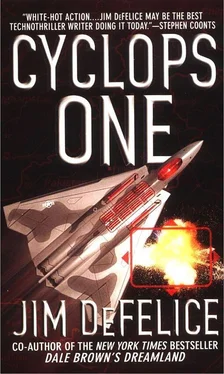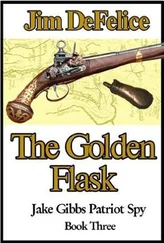“I think we should do it,” he told the President. “I think we have the potential — it could change a number of things.”
“The end of war,” said D’Amici. His tone was somewhere between tired and gently mocking. “You’re starting to sound like a brochure for the augmented ABM system.”
“I don’t think it’s the end of war,” said Blitz. “I’m not naïve. And I’m not pushing a weapons system. But I do think it’s a chance. It’ll show people we’re determined. It could have an enormous impact.”
D’Amici got up and began pacing through the room. “I think about Lincoln sometimes, walking upstairs the night his son was dying. He had all those men in uniform on the battlefield. Roosevelt, pushing himself along in a wheel-chair, or being pushed. And Ike, ordering the overflights of Russia, even as they kept taking shots at his planes. They all faced difficult decisions.”
“Thank God they made the right ones,” said Blitz.
“Sometimes they didn’t. That’s the point.” The President picked up his cup, blowing into it to cool it. “You remember during the campaign, the first time you briefed me on India? You predicted this.”
“I predicted difficulties,” said Blitz. “Not this specifically.”
D’Amici sipped his tea, then put the cup down. “Come on,” said the President, starting back upstairs. “I have to get the order out now if it’s to do any good.”
Captain Atta Habib completed a fresh round of checks with his copilot, then undid his restraints. His neck had stiffened under the weight of his helmet. He took it off as he rose, stowing it in his seat before stretching his legs on the flight deck. While the 767 could — and usually was — flown in shirtsleeves, the accident that had claimed Cyclops One had reinforced the importance of survival gear. Unlike “normal” 767s, the Cyclops aircraft were fitted with special ejection seats, specifically designed adaptations of the ACES II model standard in fighters like the F-15. The seats ejected upward through large hatchlike cutouts in the roof of the plane. The metal pins, along with tags to manually blow the hatches if the automated system didn’t work, were visible above each seat.
Atta wondered if York and her crew had thought about the ejection mechanism too. He remained convinced that they had been lost in an accident: He didn’t buy the hijacked plane theory at all; no one who knew Megan could.
Atta felt his vertebrae crack as he leaned backward, all of the muscles stretching. The flight decks on the Cyclops warplanes were more spacious than their civilian counterparts, thanks to the modifications necessary to carry the weapon. Originally designed for a three-person crew, the two-man cockpit in production 767s was a comfortable executive office; in Cyclops it was a veritable suite. Behind the pilot’s and copilot’s chairs were four crew stations for the laser, two apiece facing consoles along the wall. The configuration allowed for decent walking space to the back galley. The walking space covered the access points and one of the wire tunnels for the laser gear, but these were covered by a carpet, and the crew joked that there was enough room for a regulation bowling alley, an exaggeration that nonetheless hinted at its spaciousness. The galley included a rest room and a small kitchen area complete with a microwave and a thermos coffeemaker supposedly rated to stay inside its fitting at negative 10 g’s. Future versions of the aircraft would probably include a second crew compartment, where a reserve team could catch a snooze on a long mission.
The Boeing people hadn’t planned on making a revolutionary warplane when they drew up the 767; they were looking for an economical way of moving people around the globe. But just as they had done with the venerable 707, their fundamental engineering values had created a versatile airframe capable of going far beyond even the visionary’s dreams. The engineers and contractors working for NADT had a good basis to work on, and credited the original designers for most of their success. Habib had taken this airframe through a stress test — ostensibly for the laser nose — that included a barrel roll and an air-show loop. Granted, it wasn’t a sleek F/A-22V or a teen-series fighter, but the big jet was surprisingly nimble and extremely well behaved, even at the far edge of its advertised design limitations. Habib felt confident it would perform today.
He thought the same of his crew. The four of them together had over fifty years in the service and had spent the last year on the Cyclops project.
The same things could have been said of everyone on Cyclops One.
Atta paused behind the designating station. While the pilot actually made the shot, the designating specialist — Technical Sergeant May Peters, in this case — guided the computer as it worked with the various inputs and prioritized potential hits.
Had she been male, Atta would have given her a good-natured slap on the side or back. But he worried about doing that with a woman — worried it might be misinterpreted or, worse, that he might actually hurt her. Even though he knew Peters rather well — had met her husband and even had dinner with them once or twice — he remained formal.
“Good work, Sergeant,” he told her.
“Thank you, sir,” she said, her tone not quite as rigid as his but still well shaded toward formality.
Atta went over to the other station, which was manned by another tech sergeant, Joe Fernandez. Feeling he had to treat Fernandez the same as Peters, he repeated the same words and received precisely the same response. Satisfied, he looked over his domain one more time, pausing before returning. He had thought of making a little speech as a morale booster. Colonel Howe had given one on the tarmac earlier and he’d been impressed. But Atta wasn’t that good a speaker in front of crowds, even tiny ones; he felt something growing in his throat and decided not to chance it.
He thought of saying a prayer but worried that might be taken the wrong way: He was a Muslim, and maybe Christians would think he was imposing his beliefs on them. So instead he stretched one more time and went back to his seat.
“We’re looking good,” he told them over the interphone after he slipped his helmet back on. “Looking real good.”
Airborne and on course, Howe worked his eyes across the dimming purple sky, scanning for enemies. The integrated sensors in his aircraft would surely alert him to another plane well before he could see it, but there was no way in the world he would feel secure, no way he could fly, without using his eyes. Part of him believed, truly believed, that they’d see something the radar and infrared would miss; part of him was convinced that even the powerful radars in the AWACS and Cyclops Two were no replacement for his own Mark One eyeballs. Howe was not so superstitious — or foolish — about this that he wouldn’t trust the display on his gee-whiz tactical screen, much less forgo the very real benefits of technology. Both of his kills had come from beyond visual distance; he hadn’t seen either target before launching. But still, his eyes hunted the darkening space around him, a miner’s pan sifting for danger.
The overall plan was laid out almost exactly as the exercise dubbed Bosnia 2 had been over a year ago, allowing for differences in geography. As the Velociraptors worked over the Pakistani border near Indian Kashmir, they would feed data back to Cyclops Two, which would remain in Afghan airspace. Their low-probability-of-intercept radars could not be detected by the gear believed to be aboard the helicopters or the front-line Indian aircraft that the planners thought would be nearby; at the same time, the F/A-22Vs would be able to slide through the rough terrain, overcoming the clutter that shadowed part of the likely approach. The laser aboard Cyclops Two would make the hit, but the two Velociraptors would be close enough to strike the helicopters if it missed.
Читать дальше












